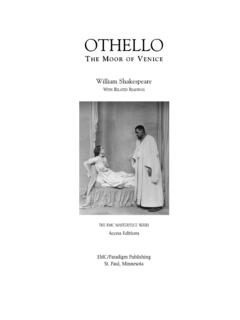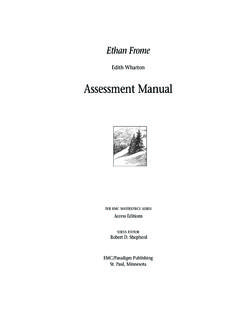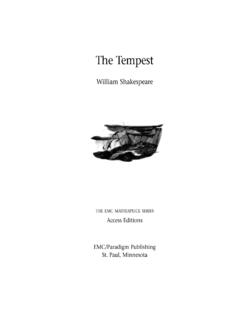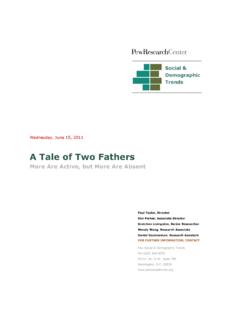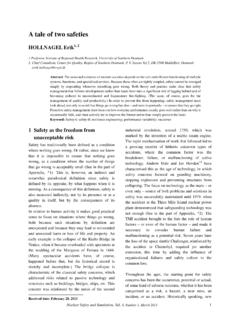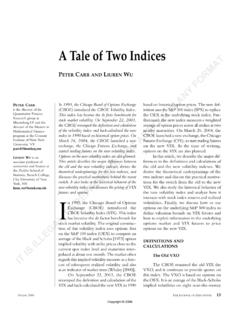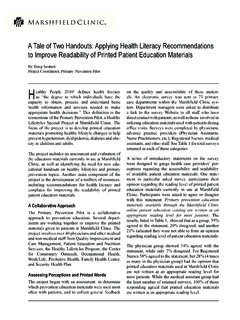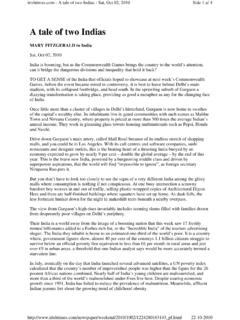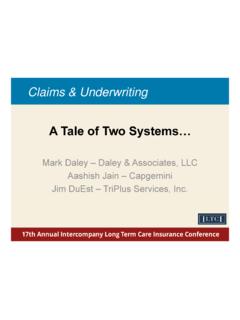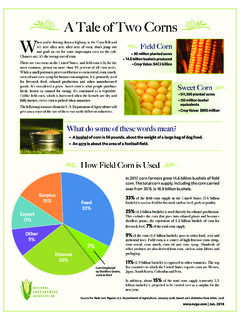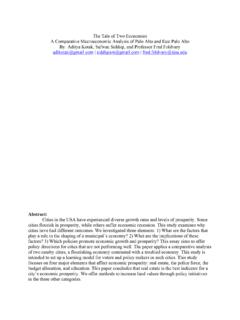Transcription of A Tale of Two Cities - emcp.com
1 a tale of two CitiesCharles DickensTHE EMC MASTERPIECE SERIESA ccess EditionsSERIES EDITORR obert D. SheperdEMC/Paradigm PublishingSt. Paul, MinnesotaStaff Credits:ForEMC/Paradigm Publishing,St. Paul, MinnesotaForPenobscot School Publishing, Inc.,Danvers, MassachusettsISBN 0-8219-1651-3 Copyright 1998 by EMC CorporationAll rights reserved. No part of this publication may be adapted, reproduced,stored in a retrieval system, or transmitted in any form or by any means, elec-tronic, mechanical, photocopying, recording, or otherwise, without permis-sion from the by EMC/Paradigm Publishing875 Montreal WaySt. Paul, Minnesota 55102 Printed in the United States of 9 8 7 6 5 4 3 2 xxx 06 05 04 03 02 01 00 Laurie SkibaEditorShannon O Donnell TaylorAssociate EditorEileen SlaterEditorial ConsultantJennifer J.
2 AndersonAssistant EditorEditorialRobert D. ShepherdPresident, Executive EditorChristina E. KolbManaging EditorSara HyryEditorAllyson StanfordEditorSharon SalingerCopyeditorMarilyn Murphy ShepherdEditorial AdvisorDesign and ProductionCharles Q. BentProduction ManagerDiane CastroCompositorJanet StebbingsCompositorThe Life and Works of Charles Dickens .. vTime Line of Dickens s Life .. viiiThe Historical Context ofA tale of two Cities .. xCharacters inA tale of two Cities .. xvEchoes .. xviiIllustration .. xviiiBOOK THEFIRSTC hapter 1 .. 1 Chapter 2 .. 4 Chapter 3 .. 10 Chapter 4 .. 15 Chapter 5 .. 27 Chapter 6 .. 39 BOOK THESECONDC hapter 1.
3 52 Chapter 2 .. 59 Chapter 3 .. 66 Chapter 4 .. 80 Chapter 5 .. 87 Chapter 6 .. 94 Chapter 7 .. 109 Chapter 8 .. 119 Chapter 9 .. 125 Chapter 10 .. 136 Chapter 11 .. 144 Chapter 12 .. 148 Chapter 13 .. 155 Chapter 14 .. 163 Chapter 15 .. 174 Chapter 16 .. 186 Chapter 17 .. 197 Chapter 18 .. 202 Chapter 19 .. 209 Table of ContentsChapter 20 .. 217 Chapter 21 .. 223 Chapter 22 .. 235 Chapter 23 .. 241 Chapter 24 .. 249 BOOK THETHIRDC hapter 1 .. 264 Chapter 2 .. 276 Chapter 3 .. 283 Chapter 4 .. 288 Chapter 5 .. 294 Chapter 6 .. 300 Chapter 7 .. 310 Chapter 8 .. 316 Chapter 9 .. 329 Chapter 10 .. 341 Chapter 11.
4 356 Chapter 12 .. 364 Chapter 13 .. 373 Chapter 14 .. 385 Chapter 15 .. 397 Plot Analysis ofA tale of two Cities .. 406 Creative Writing Activities .. 409 Critical Writing Activities .. 411 Projects.. 413 Glossary .. 415 Handbook of Literary Terms .. 433ivA tale of two CITIESTHE LIFE AND WORKS OFCharles DickensCharles Dickens.(1812-1870). Charles Dickens was born atPortsea near Portsmouth, England, the second of eight chil-dren. His early childhood seems to have been a happy one,especially when the family lived in Chatham and Charlesdevoted himself to his studies, reading his father s collectionof classic novels and plays and attending a school run by aminister who appreciated Charles s scholastic Dickens s father, however, liked to live beyond hismeans; soon after the family moved to London whenCharles was eleven, his father landed in debtor s had to leave school and support himself with a fac-tory job labeling bottles for four months before his fatherwas released and the family reunited.
5 Afterward, CharlesDickens never spoke of this experience, but the pain of itshaped Dickens s writing, particularly in his descriptions ofthe sufferings of poor children, orphans, and other victimsof injustice. This experience also created within Dickens agrim determination to leaving school again at age fifteen, Dickens workedas a clerk in the law firm of Ellis and Blackmore at Gray s , Dickens diligently studied court matters and short-hand, knowledge that Dickens soon used to launch a jour-nalistic career, starting as a court reporter. By 1832 he was ageneral reporter for theTrue Sunand a parliamentaryreporter for theMirror of Parliament.
6 On the side, he began towrite short fictional character sketches, which he publishedin various magazines under the pseudonymBoz. Havingattracted considerable attention for their lively humor, theseearly writings were published in book form in 1836 asSketches by year that followed proved to be pivotal for weeks afterSketches by Bozwas issued, the first monthlyinstallment of his first novel,The Pickwick Papers, was pub-lished, and Dickens married Catherine Hogarth, the daughterof a fellow journalist. Dickens s sister-in-law, Mary Hogarth,came to live with the young couple, and Dickens developed aromantic fixation on his wife s vivacious younger sister.
7 Mary,however, contracted a sudden illness and died in Charles sarms. Critics have suggested that several of Dickens s femalecharacters, including Lucie, the heroine ofA tale of two Cities ,may have been modeled at least in part on Mary LIFE AND WORKS OF CHARLES DICKENSvCharles DickensviA tale of two CITIESN early all of Dickens s major works of fiction were firstpublished in serial form, appearing in weekly or monthlymagazines, sometimes with hundreds of thousands of read-ers waiting eagerly for each new PickwickPapershad a slow start but quickly became a publishing phe-nomenon, and Dickens enjoyed a lavish social life andfriendships with many celebrities of the day.
8 Nevertheless,success did not keep him from writing prodigiously. In thefollowing twelve years, his major works includedOliverTwist, A Christmas Carol, Nicholas Nickleby,The Old CuriosityShop,andDombey and Son. During this time, Dickens movedfrom humor to increasingly complex social criticism of aworld that was ruled by business interests rather than humanfeeling, one which was suddenly dominated by the newmachines of the industrial Copperfield,published in 1849, is Dickens s mostautobiographical novel; it marks the point at which he hadcome to a full understanding of himself and society. In thenext decade, he published some of his greatest works, includ-ingHard Times, Bleak House,andA tale of two Cities .
9 Duringthis time Dickens also founded and editedHousehold Words,which was succeeded byAll the Year Round, weekly magazinesin which he serialized some of his own 1859, after years of increasing marital tensions, Dickensseparated from his wife and moved with most of his ten chil-dren to a country house at Gad s Hill, near his childhoodhome in Chatham. There he wroteOur Mutual FriendandGreat Expectations. In 1867 he left England for a successfulreading tour of the United States, but the traveling took atremendous toll on him and he returned to England the fol-lowing year in declining health. Even so, he insisted on mak-ing a tour of England in 1869, and a physical collapse thatforced him to suspend the tour did not keep him from giv-ing a farewell series of readings in London in the winter of1870.
10 On June 8, after a full day of work on his last novel,The Mystery of Edwin Drood, Dickens had a fatal stroke anddied the following addition to working on novels and working as an edi-tor, Dickens loved the theater, and led an amateur companyfor many years. As you will read in The Historical ContextofA tale of two Cities , Dickens wrote this novel after beinginspired by a play his theater company produced, in whichhe himself starred. Dickens s theatrical work also contrib-uted to the success of his reading tours in England and theUnited LIFE AND WORKS OF CHARLES DICKENSviiDickens did more than write: he also worked hard to rec-tify many of the social injustices he described in his novels,involving himself in welfare projects including slum clear-ance, schools for poor children, and homes for unwedmothers.


